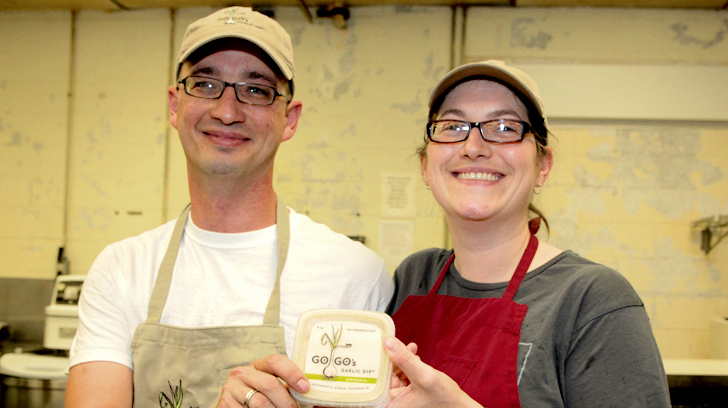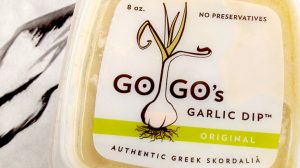For Yiorgos Samios, his Greek heritage, a job as a waiter and a fortuitous sojourn at a tavern while touring his native country were all ingredients in his recipe for entrepreneurial inspiration.
It all started nine years ago, while on a visit to see his father in New York City. There, Samios fell in love and decided to move from his home in Athens to live permanently in the United States. But while working as a waiter at an upscale Greek restaurant, he couldn’t help but notice how much diners loved the chef’s garlic dip, a traditional dish called skordalia. That observation, plus the recipe for a mouth-watering dip he’d come across during a trip to his grandfather’s village in Greece, eventually led him to make an ambitious move–founding a Queens, NY-based business to sell his own natural version of that fare, Gogo’s Garlic Dip, now sold in 35 stores throughout the New York area.
A Recipe for Success
Samios first came to New York as a tourist to visit his father, who had moved to the U.S. when he was three. When he fell in love with a Greek American woman during his visit, Samios figured he’d relocate. He started working as a plumber and then as a waiter in Greek restaurants. But over the next five years, Samios started thinking more and more seriously about launching a startup. A friend had a business selling funnel cakes and smoothies at food festivals. Combined with his restaurant work and his own enjoyment of cooking, he got to thinking he’d like to do something gastronomically related. The inspiration for his business, however, evolved over a few years. During a 2004 trip to Greece, he and his wife visited his grandfather’s village. One day, tired and hot, they ordered skordalia, a traditional bread-based garlic dip, at a fish tavern. “It immediately boosted our mood,” he says. “Suddenly, we felt happy.” Two years later, on a return visit, he asked the chef for her recipe.
Samios noticed that diners in New York seemed to prefer dip without eggplant and he added his own twist, using extra virgin olive oil and other ingredients. Then he tried it out on friends and family, and “everybody loved it.”
When he returned home and started making it for family and friends, he found they loved it, too. Soon after, Samios started working as a waiter in an upscale Manhattan restaurant, where he was struck by how much the patrons, including non-Greeks, enjoyed the skordalia. Samios realized he’d found his business—selling his own version of that condiment, based on the recipe he’d brought back from Greece.
Samios started experimenting with recipes in his own kitchen. He noticed that diners in New York seemed to prefer dip without eggplant, for example. And he added his own twist, using extra virgin olive oil and other ingredients. Then he tried out his concoctions on friends and family to get their feedback. “Everybody loved it,” he says. Encouraged by those reactions, Samios visited several gourmet shops in Manhattan, asking to see the manager. One, in particular, was a Greek American who liked the concept and told Samios to come back when he had a product in hand. At the same time, he also visited Greek stores in his neighborhood of Astoria, to see, he says, “whether Greeks liked it, too.” Turned out, they did. The other big question, he knew, had to do with shelf life. Samios’ dip was made without preservatives. If the product could only stay on shelves for a week or so, stores wouldn’t be interested. With that in mind, he sent a sample to Cornell University’s College of Agriculture and Life Sciences. The word he got back was good: The product had a shelf life of 10 weeks—and Samios could launch his business.
“He was excited about the product because Greek food is very popular,” says Samios. “It was something new in the marketplace.”
Getting Started
Samios then threw himself into researching how to set up his business. He found out about a new kitchen incubator in nearby Long Island City that rented out its facilities to fledgling food entrepreneurs. Called The Entrepreneur Space, the 5,000- square foot kitchen, operated by the Queens Economic Development Corp., was just what he needed—a place with commercial-grade equipment he could rent throughout the week. He also contacted Cornell for a step-by-step break down of how to scale up their recipes for a larger production. And he got information about everything from licensing and insurance to potential suppliers.
Insider’s Tips On How To Secure Your Place At A Kitchen Incubator
Game-changer: Selling to Whole Foods
In the summer of 2009, Samios’ wife found an advertisement in a local food magazine from Whole Foods, advertising an interest in looking at products from small, artisanal food producers. They emailed and, after three months or so of back and forth, they met with the buyer for specialty foods for the New York metropolitan area. The meeting went well. “He was excited about the product because Greek food is very popular,” says Samios. “It was something new in the marketplace.” He began working with a graphic designer to create packaging and, by the end of the year, Samios was ready to open his business. A few months later, they met with the regional management team for Whole Food’s specialty department. They didn’t come empty-handed, bringing prototypes of several flavors with them, along with a working design for packaging. The upshot: They were instructed to come back with a line of several flavors, new packaging, and to swap their lemon juice for a version without preservatives. Samios tested out recipes at a farmer’s market in Deer Park, about an hour and a quarter drive from his home; about eight months later, he expanded to a big farmer’s market in Park Slope, Brooklyn.
To fund operations, Samios borrowed money from family. He also took out a $6,000 loan from a micro financing organization they’d heard about at a seminar on financing.
In the meantime, they looked for a new lemon juice supplier and finalized their packaging. Finally, they were ready to see Whole Foods again. At a meeting with team leaders for 21 stores in the area, they made their presentation—and they were in.
Want To Sell Your Product To Whole Foods? Read this.
Challenge – Distribution
Fearing they wouldn’t be able to keep up with demand, Samios decided to start by supplying only six stores in Manhattan. They hand delivered orders themselves or used a courier service with refrigerated cars when they couldn’t handle the work on their own. At the same time, he expanded to half a dozen or so farmer’s markets in Westchester county, a suburb of New York City. About four months later, Samios felt he was ready to expand to other stores. That decision was made easier when Whole Foods introduced him to a natural foods distributor in the Bronx. “That’s usually a challenge for small food entrepreneurs,” he says. “But all the vetting they needed was that Whole Foods wanted us.” They quickly established a routine. Samios spent Tuesday nights making his dip at the Entrepreneur Space, paying to refrigerate it there overnight. The next day, the distributor picked it up. To fund operations, Samios borrowed money from family. He also took out a $6,000 loan from ACCION, a micro financing organization they’d heard about at an SBA seminar on financing they’d attended. That money primarily has gone to pay for their biggest expense, containers needed to package their dip.
Six Step Guide On How To Sell Your Product To Whole Foods
Next Steps
Much of the Samios’ time now is devoted to doing in-store demonstrations of his dip, a necessary step to sell an unknown product. “It’s unique,” he says. “No one would know what it was otherwise.” They’re also experimenting with new flavors—for example, they’re testing out a dip made with whole wheat, instead of their usual country-style, bread. And they selling to other stores, some thanks to customer demand, others from introductions made through their distributor. This year, they’ve added 20 stores and they’re hoping to add 30 to 40 more. Revenues have grown 20% to 30% every six months since starting up. Says Samios: “The future looks bright.”
Where to find Yiorgos Samios’ Gogo Garlic Dip
Advice from Yiorgos Samios
We talked to Greek native Yiorgos Samios, creator of Gogo’s Garlic Dip, to get his perspective on becoming an immpreneur.
What are the advantages to being an entrepreneur in the U.S. rather than in Greece?
Samios: The information needed to build your business can be found much faster and more easily in the US. Also, gathering the required paperwork and documentation is easier.
What are the advantages to being an immigrant entrepreneur?
Samios: I had knowledge of a food product because of being Greek that represented a unique business opportunity. Plus, in selling situations, New Yorkers love my accent.
What advice do you have for an immigrant thinking about becoming an entrepreneur?
Samios: Remind yourself where you have come from, where you are now, and take courage from that. Success will continue to grow if you work with passion.


